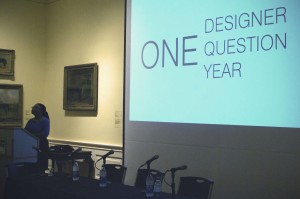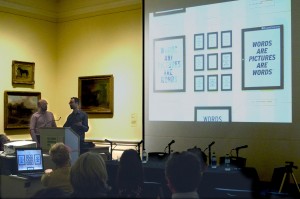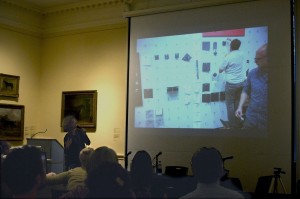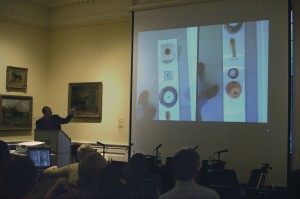On Saturday, October 18th, AIGA Baltimore opened its third annual Design Week at the Baltimore Museum of Art with a roundtable discussion on immersive spaces.
The Big Table is a project headed off by Baltimore Museum of Art (BMA) that strives to address questions and criticisms about art posed by visitors. Each year, a designer or a team of designers is chosen to address one question or idea. Bruce Willen and Nolan Strals from Post-Typography, Ellen Lupton and Abbott Miller from MICA and Cooper-Hewitt (respectively), and David Plunkert of Spur Design, have all designed for The Big Table over the past few years. They gathered together to discuss their concepts at the BMA in the Fall of 2014.

Gamynne Guillotte, Director of Interpretation & Public Engagement for the BMA, talks about the purpose and format of The Big Table.
Words are Pictures are Words
How do contemporary artists use text in their work? Willen and Strals approached this question by considering language and how meaning changes depending on how it’s written. They created their immersive space, titled Words Are Pictures Are Words by using that same phrase in several contexts, including a room-sized infographic, showing how the meaning of the phrase changes depending on type, style, and arrangement.

Willen and Strals talk about their concept for Words Are Pictures Are Words.
Point, Line, Grid
“The idea becomes the machine that makes the art.” This quote by Sol Lewitt inspired Ellen Lupton and Abbott Miller to create the work Point, Line, Grid. They created a bulletin board-style grid that explores the way an artist thinks by inviting visitors to create and display their own artwork to dominate the room for the next year. The environment was created to point to the inspiring artwork while letting the visitors create something of their own.

Ellen Lupton talks about how they implemented the grid on the walls, and suddenly the room became an interactive experience for viewers…or shall we say, participants?
Extra-Ordinary Objects
David Plunkett says that an object in a museum becomes something more important because it’s in a museum. He approached his Big Table project by studying the permanent exhibits in the contemporary wing and making a list of the common items he saw there and in an everyday environment. The resulting work, Extra-Ordinary Objects, is a room about objects one could find anywhere, remixed and displayed in ways that were unusual, presenting the viewer with a new, amusing way to see the relationships between those everyday objects. It will be on display in the Contemporary Wing until September 2015.

David Plunkert talks about a few of his extra-ordinary objects.
To see more photos from this event, check out the set on Flickr.
Greg Jericho spends an awful lot of time designing for clients that do not exist. Check out his work at gregoryjericho.prosite.com.